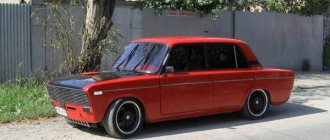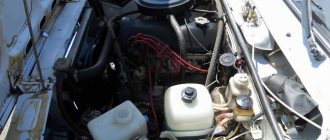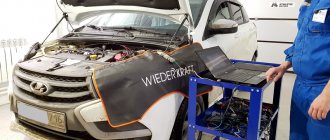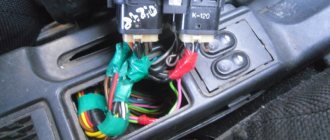The VAZ-2112 hatchback, which entered production line production in 1999, became the final link of the “tenth” division. Lada 110 represents a family of vehicles that were produced from 1995 to 2008 at AvtoVAZ and other production facilities. The main car of the division was the VAZ-2110 model. The VAZ-2112 was replaced by the older model Lada Priora. The entire Lada model range.
Car history
In 1983, the design of a sedan on the platform of the VAZ-2108 hatchback began. The project was named VAZ-2110. But it's interesting that the design team made too many changes that made the car more expensive. Because of this, in 1984, this project was separated from the project of a simple “transition” of the VAZ-2108 into a sedan (which later received the name VAZ-21099).
The first experimental version of the “ten” was released in July 1985. The management had plans to put the car into mass production since 1992, but the ensuing economic crisis had an impact. The debut versions of the “ten” were released in June 1995. AvtoVAZ was directly involved in production.
VAZ-2110 Experienced
Serial production of the cars began in August 1996, and the new product could be purchased already in the same year. In those years, global automotive technology rose to a new level and a breakthrough car until the end of the 1980s could not be called a completely new vehicle. But despite these and other complaints about build quality in the 1990s, the car was a clear step forward for the Soviet automobile industry.
If we compare the Zhiguli and Samara, the 2110 was positioned as a higher-class car that was modern and competitive both externally and internally. To be more precise, the VAZ-2112 has an electronic powertrain control system (although the debut versions came with carburetors) and a diagnostic unit (on-board computer).
In addition, it was possible to install a hydraulic power steering wheel and electric windows on the Lada 2112. Body parts were made of galvanized metal, new body painting technology was used, and so on. Issue 2110 marked a new stage in the development of the Soviet automobile industry. The hero of our article, Lada 2112, appeared a little later, in 1999, almost immediately after the VAZ 2111 station wagon. Today we will get to know this domestic model better.
Test
Correct accents
When creating this car, the developers relied on the rapidity of the body shape and were right. Even in our time, “Twelfth” looks modern and, to some extent, attractive. And, at the time it went on sale, it was considered one of the most spectacular cars in its segment on the Russian market.
Lada 2112 attracts attention with its elongated headlights, convex hood, laconic front bumper, and sloping roof. However, wide rear pillars can significantly limit the driver's view.
Moderately convenient
The front panel looks ascetic and outdated - the square outlines of the dashboard are repulsive. The finishing materials are also not impressive - the plastic is loud and hard, and the door panels are upholstered with branded material.
In addition, the fit of the panels is generally uneven, which indicates mediocre build quality. However, the ergonomics are not bad - the main controls are arranged around the driver and in close proximity to him.
The instrument panel is highlighted by green lighting and two trip computer screens. On the center console there is a clock, a door open indicator panel and warning lamps, as well as a climate system in the form of two toggle switches. At the very bottom of the console you can see an ashtray, but opening it will be problematic if an odd-numbered transmission stage is engaged.
Appearance
Due to the galvanized bodies of the “ten,” there was a lot of noise during their release, however, if you walk down the street, you can notice rust and even through holes in the thresholds of the cars. There are owners of fresh 2112s, and not only this model of the 10th family, who decided not to apply anti-corrosion treatment to their galvanized body. For this reason, the bottom of such cars quickly became covered with rust.
The twelfth model turned out to be 93 millimeters shorter than the “sedan” version. The docking affected only the rear overhang area, but the wheelbase of the two cars is the same. If we compare domestically assembled vehicles represented by the “chisel” and the VAZ classic, the twelfth model has good aerodynamics even by today’s standards.
The drag is 0.3. Since 2003, small-scale assembly of the VAZ-21123 began, which differs from the standard version by a 3-door body. The doors of the VAZ-21123 are 200 millimeters longer than those of the standard twelfth model. The Lada 21122 car had an eight-valve engine and 13-inch wheels, and a more powerful version came with a sixteen-valve power plant and 14-inch wheels.
It is important to note that in addition to the 3-door body, the VAZ 21123 received more developed wheel arches, so tuning enthusiasts are allowed to install even 15-inch stylish “rollers” on the car. If we take into account the Lada Kalina, then it is classified as division B, but the 10th division and the twelfth model in particular tends to belong to class C.
VAZ 2112 is 320 millimeters longer in length than the same Lada Kalina hatchback. However, the dimensions of the domestic hatchback do not allow it to completely fit into the grown-up modern Golf class. It’s a little unusual and even unpleasant that the company decided to install a cooling radiator under the air intakes of the nose bumper, which for some reason did not receive additional protection.
Quite often, the following happens: a stone gets into the radiator, pierces it and causes a leak. They decided to leave the front part of the “two-piece” unchanged. The headlights included mounting lenses. A hood mounted on 2 shock absorbers was simply chic in the Soviet automotive industry at that time. The sides of the hood overlapped the sides, and the hood itself had complex bends, which made its release a little difficult.
The side part of the Lada 2112 turned out to be really fast and sporty. The side is a little slick, has molded bumpers and thoughtful aerodynamics. Everyone has been accustomed to the design of this car for a long time. We cannot talk about whether he is handsome or not, since this is already part of our life. Absolutely any domestic driver will recognize this vehicle.
After its first release, most people thought it was a foreign car. Everyone felt good about the design, but today the VAZ 2112 has many competitors. People have already forgotten about this car, but in terms of design it is in no way inferior to modern foreign cars.
From the very beginning, the car, both externally and internally, was conceived as a sports version of the standard 2110. Trying to standardize the cars in the same way, it was decided to leave the rear lights as they were, the then fashionable strip running across the entire rear. The spoiler that was placed on the rear door is not a design whim, but rather a necessity. It appeared due to the occurrence of lifting force during movement.
Interior
If a person who drove a “tenth” model sits in a “two”, he will instantly find a fairly important difference. The gearbox housing is made of plastic and in the VAZ-2112 it is slightly larger. Because of this, from the right side of the edge of the brake pedal to the transmission tunnel-gearbox housing is approximately 9 centimeters. It turns out that within these 9 centimeters there should still be a gas pedal.
It is clear that pressing such pedals is not so convenient, because together with the accelerator pedal you can press the brake in the reverse order. The steering wheel is exactly the same as in regular “tenth” models. The cars received an adjustable steering wheel. As for the seats and door panels of the twelfth model, they were covered with fabric in the same color as the vehicle body itself.
Due to the wing mounted on the luggage compartment lid, the level of visibility drops significantly. Some car owners decide to dismantle it, also justifying it by the fact that this improves the appearance of the Lada 2112. The glove compartment, located in the “two-piece” in front of the front passenger, turned out to be quite spacious and can accommodate A4 sheets.
The expensive version of the Luxury Lada 2112 received a trip computer that informs the owner about the current fuel consumption, average consumption and how far the car can travel on the remaining fuel.
Speaking of the front panel, it reminds some of the familiar lowest torpedo from the early releases of the G8. Engineers were able to create a convenient instrument cluster. Of course, there are some inconveniently located control buttons, but the torpedo itself as a whole is not as bad as it might seem.
It’s worth being frank: the twelfth model has hard plastic that often produces creaking sounds, but it is clear that it is much more ergonomic than the “eighth” family. In the center you can see the famous signaling device with a drawing of a car, informing the driver that not all doors are closed. On the side there is a clock, an emergency signal button, which could have been made a little larger, as well as adjustments for the stove and damper.
In general, sitting at the helm of the Lada-2112 is quite free. However, the steering wheel covers the buttons for lights, fog lights and heated glass. The switches are conveniently located under the steering wheel, so there is no need to reach them. The steering wheel is precisely adjusted in thickness, so it is convenient to use. I would especially like to thank the engineering staff for installing height-adjustable seat belts.
There is enough free space at the feet of the person sitting in front. The factory decided not to spoil the door trim in any way, so it evokes more pleasant emotions than, for example, the hard plastic of the Lada Priora. The presence of a pleasant, fleecy upholstery material and a convenient pocket at the bottom will only please the driver. The rear end can no longer please so much. A passenger sitting on the back sofa of a VAZ 2112 will slightly touch the front seat, but the sofa itself is quite comfortable.
It is two-part (the back is divided into 2 parts). It was “transferred” to the twelfth model from 2111. This made it easier to transport luggage. The average person doesn't hit the ceiling with their head. Inspecting the ceiling upholstery, you can notice a rather interesting element. The black plastic box has a sensor that sets the optimal temperature inside the car.
It cannot be said that the luggage compartment of the VAZ 2112 is very large, but it is not small either, as for this class. For the driver, 399 liters are provided. But if necessary, this figure can be increased by folding the back of the “gallery” in parts in a ratio of 2:1, which already provides a volume of up to 730 liters of usable space.
The hatchback's underground raised floor has a standard set - a full-fledged spare wheel and the necessary tools. You can also notice a small shelf for light items on top. Speakers were placed near the rear windows. Another difference from the 8th family of cars is the low loading height, which makes loading/unloading luggage much easier.
More about airbrushing
This term hides the process of artistic painting using a special tool - an airbrush.
With its help, paint is applied with compressed air supplied by a compressor. Cars began to be decorated with airbrushing in the second half of the last century. It all started with bikers who wanted to stand out among the gray mass with their motorcycles. This is how they emphasized their individualism. Owners of the Lada 2112 also love to decorate their cars and emphasize their personal style.
In airbrush, the design is applied in three ways:
- traditional method: using an airbrush, drawing is done by hand;
- stencil: the design is sprayed with a spray gun;
- The film with the finished pattern is glued to the body.
Airbrushing on cars
Experienced airbrush specialists say that the method of airbrushing is not so important. It is much more difficult for the vehicle owner to decide on the theme of the drawing. For example, the owner of a VAZ 2112 Coupe needs to combine the desired layout theme with the design of the car.
The traditional airbrush painting process has remained the same for many years: outlines are drawn by hand, and then paint is sprayed. Using an airbrush you can do delicate work that cannot be done with a regular painting tool.
This method has many advantages over others: quality and durability, a huge selection of images, and when cleaning and polishing the body, the image is not damaged.
Drawing
The disadvantages include significant cost, the need for a highly qualified artist (since it is impossible to correct inaccuracies), and difficulties with the future sale of the car. Using a stencil reduces the cost of the procedure. But there is a huge risk that exactly the same pattern will be on several more cars.
The film method involves gluing painted films onto the car. Photographs, scanned and enlarged, are usually used as drawings. This method of airbrushing has the main advantage of low cost of work, less time consuming to complete it, and quick removal of the picture if you get tired of it. Its disadvantages: fragility, rapid destruction under the influence of environmental factors.
Specifications
Power unit
For the Lada 112 car they offered a line of in-line four-cylinder petrol engines, which many are familiar with from the “ten”. At the beginning, the hatchback had a 1.5-liter power plant with a carburetor power system. As a result, the engine developed 73 “horses” and 109 Nm.
However, very quickly this “engine” was changed to eight- and sixteen-valve power units that received multi-point injection. The working volume of such engines was 1.5 - 1.6 liters. The new engines produced 79-90 horsepower and 109-131 Nm of torque. They consume engines from 7.3 - 8 liters in mixed mode.
In essence, the VAZ-2112 engine is a qualitative evolution of the VAZ-2111 power plant, but it has already received a 16-valve gas distribution mechanism instead of eight valves. Among the main differences are the use of 4 valves for each cylinder, 2 camshafts, which helps the engine supply more fuel-air mixture into the combustion chamber at a time and quickly remove exhaust gases into the exhaust system.
Up to 3,000 rpm, the engines function almost equally, but when the needle passes the 3,000 mark, the 16-valve engine shows itself more dynamically. Interestingly, gasoline consumption is lower than with an 8-valve engine (2111). The engine itself (1.5) is injection, in-line and has an overhead camshaft.
The gas distribution mechanism has a belt drive. Many VAZ-2112 owners have experienced a broken timing belt. This is a very unpleasant event, since when the belt breaks, the gas distribution mechanism bends the valve. The new cylinder head has hydraulic compensators, which allows drivers to avoid adjusting valve clearances. In addition, the main bearings have additional oil channels.
Transmission
Together with the power plant of the Lada-2112, a mechanical five-speed gearbox operates. All torque is transmitted only to the front wheels. The first hundred kilometers is reached in 12-14 seconds. The maximum speed limit does not exceed 170-185 kilometers per hour.
Chassis
In technical terms, the domestic hatchback is not much different from the “standard” sedan. The basis was a front-wheel drive “trolley”, which has an independent McPherson-type suspension in front and a semi-independent structure with a torsion beam in the rear. The steering device has a rack and pinion mechanism, and the braking system has disc brakes at the front and drum brakes at the rear.
Tuning
VAZ-2112 is one of the best solutions of the Russian automobile industry. The car has little comfort. However, many people strive to highlight their vehicle through tuning. Nowadays, tuning has become very popular, especially for domestic cars. Due to the fact that manufacturers have reduced the body size, the hatchback has become more comfortable to drive.
Another advantage can be added to the high ability to maneuver during turns, which makes this car look like a sports class car. “Dvenashka” is, on the whole, a complete and comfortable car, but almost every master will find something that needs to be improved. For example, you can update the silhouette of a car. For this, various additions are used that allow you to create a new appearance for the Lada 2112. In addition, experts advise increasing the aerodynamic data of the vehicle.
Appearance tuning
To change the appearance, new body components should be used. Some VAZ-2112 owners resort to a stylish aerodynamic body kit, which can have a different appearance. There is a sporty type, and there is a body kit that emphasizes the unique style and characteristic feature of the Soviet hatchback.
After installing such body kits, the “two-piece” will be a little similar to American cars. There are two types of aerodynamic body kit for such a five-door:
- The first - with a sporty bias - affects the smoothness of control when moving at high speed due to the correct structure;
- The second is one that improves style. The kit includes an impressive air intake, which allows you to easily cool the power unit and braking system.
You can upgrade your car if you work on its lighting. The lighting is installed not only under the bottom itself, but also the lights located at the stern. More modern front optics will help rejuvenate the hatchback, giving it a sporty touch. In this case, LED lighting is used.
On the practical side, you can install a heated windshield, which helps save a lot of time when cleaning the glass in winter. In the warm season, such tuning of the VAZ-2112 helps reduce fogging of the vehicle.
Interior tuning
The interior of the car is the favorite part of the car for tuning enthusiasts. Typically, owners decide to install lighting in the interior. Not everyone likes the standard dashboard lighting. Such work can be carried out by any car owner of a Lada 2112 hatchback. There are craftsmen who replace the ceiling with one similar to that of a Lada Priora.
It fits perfectly as it matches the dimensions. Similar actions are carried out with door trim. To improve the level of comfort, noise insulation work is being carried out. Also, for convenience, new seats with good lateral support, a high-quality music system, etc. are installed.
Tuning the technical part
To modernize the technical characteristics of the twelfth model, it is important to increase the displacement. It is determined based on the stroke diameter and piston. To increase this volume, use a factory version or do-it-yourself improvement. If you choose the second case, you will have to convert the factory stroke, but in this way it will not be possible to significantly increase the volume.
Engine chip tuning is very popular today. There is an economical and original sports version of chip tuning for the VAZ 2112. The sports method includes increasing the dynamic performance of the car in the city. You will have to be prepared for increased fuel consumption.
If your large fuel appetite is a bit daunting, you can switch to gas equipment. The economy option reduces fuel consumption in the city, which is what many people are interested in.
These works are carried out using special equipment and skills, so it is strongly recommended to carry out such processes at high-quality service stations.
Technical tuning: power, handling and style
To ensure that there is no gap between the dynamic appearance and the actual characteristics of the car, there is technical tuning aimed at increasing engine power and improving driving performance. Among the methods of engine tuning, one can distinguish software chip tuning, associated with changing the engine control program, and physical intervention in the engine design.
The factory settings of the engine control program are focused on gentle operating modes. Changing the program requires special skills and equipment, but allows you to gain up to 20% in power.
Physical methods of engine tuning include installing a lightweight crankshaft with an increased crank offset (up to 78 mm compared to the standard 71 mm), lightweight connecting rods and modified pistons. An increase in power will also be provided by grinding the cylinder chambers, adjusting the intake and exhaust channels (boring “steps” at the interface points).
Boring of cylinders to a larger diameter is also used (up to 84 mm with a standard diameter of 79 mm on VAZ engines). The selection of piston groups will also be required.
Increasing the power of the power unit entails increasing the load on the chassis, so a logical continuation of tuning is modification of the suspension (manipulation of shock absorbers, suspension arms, installation of spacer beams, brake system and wheels (replacing disks and tires).
Owner reviews
Owners of the VAZ 2112 note that this car is one of the best domestically produced cars. Drivers talk about ease of repair, good fuel consumption and relative speed stability. Parts are much cheaper than similar foreign cars. The car is quite reliable, there is a large training ground for tuning enthusiasts.
The good agility of the car was influenced by excellent aerodynamics. On the other hand, the 2112 is far from a foreign car, so you can find dancing body gaps, low quality metal, zero safety, a creaking interior and insufficient space for rear passengers.
The quality of spare parts also leaves much to be desired. However, for a first car, a domestic hatchback is ideal. The car also has front-wheel drive, which makes driving easier in winter.
Tuning VAZ 2112 is simple and stylish
Tuning of domestic cars is of constant interest to car enthusiasts. With the advent of the VAZ hatchback body type, implemented in the VAZ 2112, the opportunity arose to experiment with this type of car. Tuning the VAZ 2112 (photo below) is the most popular, because in the line of similar cars it is the best option.
Thanks to the fact that the developers have made the body smaller, the car has become more convenient to drive. Also a plus is its maneuverability when cornering, which makes the VAZ 2112 look like a sports car.
What sets this model apart is the presence of a more attractive design of the interior space. The car has universal properties, especially when transporting luggage and cargo. About the same as the VAZ 2109, the tuning of which is similar to the tuning of the VAZ 2112. The comfortable rear backrest of the car allows it to accommodate sufficient volumes. And since it folds separately into two parts, both the passenger and the cargo being transported can fit in the back.
Advantages and disadvantages
Pros of the car
- Low cost;
- Acceptable ride height;
- Easy to repair and inexpensive spare parts;
- Front-wheel drive;
- Acceptable luggage compartment volume;
- Low aerodynamic drag;
- Possibility for tuning;
- Hydraulic power steering;
- Full spare tire.
Cons of the car
- Outdated external design and interior;
- Poor quality assembly;
- Frequent breakdowns;
- There are unpleasant sounds inside the cabin;
- Little free space;
- Uncomfortable seats;
- Low level of security;
- Lack of power.
Salon
In addition to body design modifications, drivers often make changes inside their cars. Common types of tuning the interior of the “tens”:
- Buying a new audio system and installing subwoofers in the trunk of a car.
- Improving car sound insulation.
- Replacing the factory dashboard with a new one. An updated accessory often includes additional options, such as a temperature sensor.
- Buying new heated and adjustable seats.
- Replacing the original steering wheel. A new steering wheel is often adjustable.
Thanks to the favorable price-quality ratio, the VAZ 2110 and its variants have become popular among Russian car enthusiasts. The low price and simplicity of the design allow tuning and making changes to the “top ten” that improve its appearance and technical characteristics.
Sources
- infokuzov.ru/tuning/vaz-2110-2112
- vazdriver.ru/foto_tyuninga_vaz2112/foto_tyuninga_vaz2112.html
- avto-all.com/rossiyskie-avtomobili/tyuning-vaz-2112-prosto-i-stilno
Results
Although the VAZ-2112 car has not been produced for a long time, it can be seen quite often on the streets of many cities in the post-Soviet space. The car was able to prove itself well, especially at the beginning of production. Many even mistook this hatchback for a foreign car. Even today, the car does not have such a rough design as, for example, the “nine” or similar cars, and even looks modern.
If the driver does not leave his car unattended, it will look good. “Dvenashka” received an average ground clearance, front-wheel drive, a more or less good interior and a spacious trunk. It is clear that the model cannot compete with foreign cars, but for its price it is the best option.
It is especially suitable for tuning lovers, as it has a lot of opportunities for improving the appearance, interior and technical parts. It will not be possible to avoid a poor-quality interior and low level of noise insulation. Also inside, especially in the back row, there is not enough free space. Creaking sounds will constantly accompany the driver on the road.
The power of the power plants is not always enough; the lack of power is mainly felt when overtaking. But the engine can be called quite economical, even in urban areas. The VAZ 2112, although not an ideal car, is good for a first car, as it has a low cost on the secondary market, low price tags for spare parts and is easy to repair.
We advise you to read the article: History of AvtoVAZ - LADA cars
Self-tuning VAZ 2110, 2112
In the summer of 1995, the first production copies of the VAZ 2110, popularly known as the “ten,” rolled off the assembly line of the Volzhsky Automobile Plant. Based on this model, two more cars were later developed: the VAZ 2111 station wagon and the VAZ 2112 hatchback. When tuning the VAZ 2110 and its modifications, you need to know the features of upgrading this car yourself.
VAZ 2112 photo
Read more:
Car checking service by VIN code
The German company Audi decided to announce the cheapest version of the electric crossover
Anyone willing to pay $55,000 for a well-kept version of a 1991 BMW M5?
The German company VW is preparing in full for the presentation of its own new SUV, the Volkswagen Tacqua.
Aurus limousines decided to be produced in the United Arab Emirates











